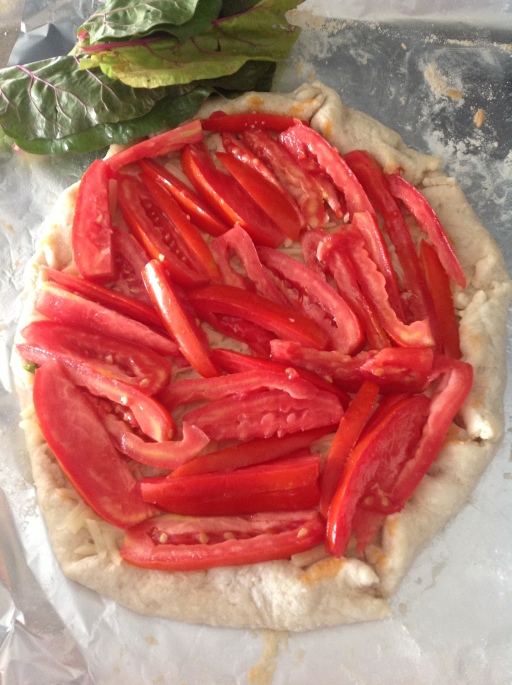Most home gardeners — and even CSA subscribers — end summer with a plethora of tomatoes. Once upon a time, when I was single and living alone in the Detroit suburbs, I planted six tomato plants in my backyard, not realizing how many tomatoes each one would produce.
Wow. That was a lot of tomatoes. (Unbelievably delicious tomatoes, I might add.)
That’s the summer I learned how to make a tomato tart. It’s easy, it’s tasty, and it uses up a lot of tomatoes as well as basil, if you have an excess of that, too.
To start, you need a crust. To simplify the process, you can buy a frozen pie crust. Or, you can whip one up. Seriously, making pie crust from scratch doesn’t take long, and if you don’t use a tart pan (shallow pie-type pan with a bottom that drops out), you can roll the dough out right onto your baking sheet.
I always use my grandma’s pie crust recipe, which is also my go-to crust for apple pie. She passed away when I was in the second grade, but I don’t think she’d mind if I shared it.
FLORENCE’S PIE CRUST
Ingredients
1 cup flour (I use all purpose)
1/2 cup shortening
1/4 cup cold water
Instructions
1. Preheat oven to 450 degrees.
2. In a bowl with a wider base, cut the shortening into the flour with a pastry blender.
3. Once the mixture has turned into little balls, add the water. Keep mixing until you’ve created a ball of dough.
4. Remove the dough ball from the bowl. At this point, you can roll it out and put it in a tart pan or, like I noted a few paragraphs ago, roll it directly onto a cookie sheet. I used a tart pan for years, but just this summer realized that I like the way the finished tart looks when it bakes on a cookie sheet. More artisan, I guess.
5. Partially bake for about 7 minutes.
Yeah, that’s it. You can also use a food processor or stand mixer to make your dough. But to be honest, I find that’s a lot of cleanup for something you can accomplish in a matter of minutes with a little elbow grease, a bowl and a pastry blender.
Here’s how the rest goes.
TOMATO TART
Ingredients
About 4 tomatoes, less if they’re large, cut into thin wedges (Roma tomatoes work best, because they’re drier, but other varieties are fine, too. Just let them drain on a paper towel after you cut them up)
3/4 cup basil, chopped
1 1/2 cup shredded cheese (I like Trader Joe’s Gruyere and Swiss mixture but mozzarella is fine)
1/2 cup mayonnaise
3-4 cloves garlic, minced
Spinach, kale or Swiss chard (optional)
Instructions
1. Reduce oven to 375 degrees.
2. Arrange tomatoes on top of your partially baked crust. Try to fit them snugly instead of layering them.
3. Layer greens on top of the tomatoes, if you’re using greens.
4. Mix together the basil, cheese, garlic and mayo. Spread the mixture on top of the greens (or the tomatoes, if no greens).
5. Bake for 20 to 25 minutes, or until the cheese is nice and golden. Let the tomato tart sit for about 5 minutes before diving in.
Here’s a partially baked crust with tomatoes:

With Swiss chard:

And then with the mayo mixture:

Out of the oven and plated:

 A quick search revealed this recipe for rhubarb blueberry muffins. Jackpot! I was intrigued that sour cream was on the ingredient list, I had frozen blueberries in the freezer that I’d bought but never used for smoothies, and I knew there was at least a cup of rhubarb.
A quick search revealed this recipe for rhubarb blueberry muffins. Jackpot! I was intrigued that sour cream was on the ingredient list, I had frozen blueberries in the freezer that I’d bought but never used for smoothies, and I knew there was at least a cup of rhubarb.



















